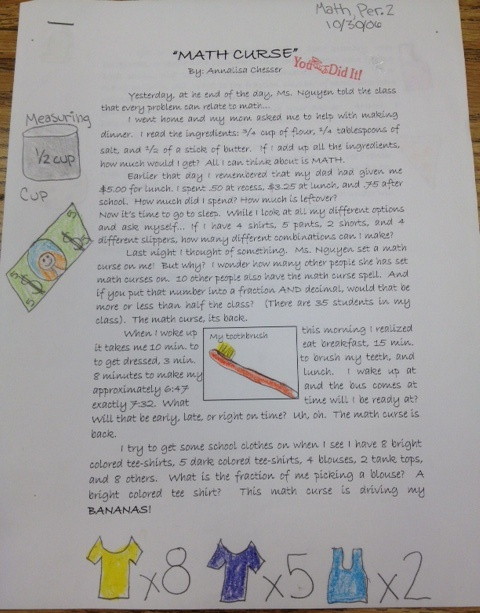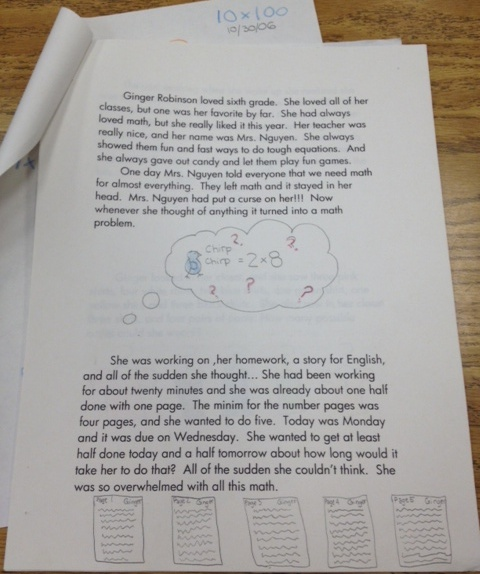My Other Math Sites
Lessons From the Classroom
Tracy Zager's New Book
Two plus years ago Tracy Zager contacted me for an interview about a post I’d written; she said she’d like to include parts of it in a book she was writing. Of course I was honored and stupid with joy. Then I got to meet Tracy in person at a math conference in 2014. Her warmth radiates wildly and affectionately. Then I got to be her designated live-tweeter for her ShadowCon talk the following year. But between our two face-to-face meetings, Tracy had been diagnosed with breast cancer. Cancer fucked with the wrong woman. Tracy is grace and heart and badass. How blessed and honored I am to call her my friend.
Here is her beautiful book.
I’ll be sure to remind you when it comes out. :)
A Book: Thinking Mathematically
I'm re-reading Thinking Mathematically, an assigned book from a math course I took years ago in Portland. I was teaching science at the time but signed up anyway because I've always loved math.
Thinking is still so good and resonates much more now that I've been teaching mathematics.
In the Introduction, under "How to use this book effectively!":
Recalcitrant questions which resist resolution should not be permitted to produce disappointment. A great deal more can be learned from an unsuccessful attempt than from a question which is quickly resolved, provided you think about it earnestly, make use of techniques suggested in the book, and reflect on what you have done. Answers are irrelevant to the main purpose of this book. The important thing is to experience the process being discussed.
... our approach rests on five important assumptions:
You can think mathematically Mathematical thinking can be improved by practice and reflection Mathematical thinking is provoked by contradiction, tension and surprise Mathematical thinking is supported by an atmosphere of questioning, challenging and reflecting Mathematical thinking helps in understanding yourself and the world
These assumptions need to live in our classrooms.
The problems in Thinking are mostly brief and simply stated -- yet each one has the potential to make you linger a bit longer because you want to savor your own thinking. Not even productive struggle, this is sweet struggle.
How many rectangles are there on a chessboard? [Page 43]I have just run out of envelopes. How should I make myself one? [Page 35]A certain village in Jacobean times had all the valuables locked in a chest in the church. The chest had a number of locks on it, each with its own individual and distinct key. The aim of the village was to ensure that any three people in the village would amongst them have enough keys to open the chest, but no two people would be able to. How many locks are required, and how many keys? [Page 176]
I'm finding out that the 2nd Edition came out in 2010. Amazon does not have it in stock currently, but when it does become available, we can rent it for $54.77 or buy it new for $91.29. What??
Sharing My Favorite Math Books With Students
In my next life, I hope to be able to collect pretty shoes the way I’m collecting math books in this life. Of course I haven’t read them all. Not even close. But just seeing them on the bookshelf makes me happy.
A good book is nothing if not shared.
I always share some of my favorite math books with students. I bring them in so the kids can see the cover, the thinness of it, the fatness of it. “Here’s what the author looks like. Let’s pronounce the author’s name correctly.” I read the book jackets to them. I tell them the year it was published—how many editions so far. We look at the illustrations and say ooh-ahh-wow. I share some of the reviews.
I read at least one or two passages from the book. No matter how old the students are, they love this. They say, “Ooh, goody, story time!” Their eyes are on me. They “curl up” in their hard chairs. They want me to begin.
The latest book is Steven Strogatz’s The Joy of X. I read the first paragraphs of “Loves Me, Loves Me Not” (Chapter 20) to my 8th grade geometry class:
“In the spring,” wrote Tennyson, “a young man’s fancy lightly turns to thoughts of love.” Alas, his would-be partner has thoughts of her own — and the interplay between them can lead to the tumultuous ups and downs that make new love so thrilling, and so painful. To explain these swings, many lovelorn souls have sought answers in drink; others have turned to poetry. We’ll consult calculus.
[...]
To illustrate the approach, suppose Romeo is in love with Juliet but that, in our version of the story, Juliet is a fickle lover. The more Romeo loves her, the more she wants to run away and hide. But when he takes the hint and backs off, she begins to find him strangely attractive. He, however, tends to mirror her: he warms up when she loves him and cools down when she hates him.
I show them the love-hate-relative-to-time graph that follows. Then I say, “Take calculus in high school so you can plot your own Romeo–Juliet graph.”
Later, I have them do a construction from Chapter 13, “Something from Nothing.” Given a segment, or one side of a triangle, construct the other two sides to form an equilateral triangle.
I admit I tend to favor pieces of work that show thoughtful struggle.
All I have to do is read Chapter 0, “Null and Void,” in Charles Seife’s marvelous little book Zero: The Biography of a Dangerous Idea, and the kids are hooked.
Zero hit the USS Yorktown like a torpedo. On September 21, 1997, while cruising off the coast of Virginia, the billion-dollar missile cruiser shuddered to a halt. Yorktown was dead in the water. Warships are designed to withstand the strike of a torpedo or the blast of a mine. Though it was armored against weapons, nobody had thought to defend the Yorktown from zero. It was a grave mistake... Zero was at the heart of the battle between East and West. Zero was at the center of the struggle between religion and science. Zero became the language of nature and the most important tool in mathematics. And the most profound problems in physics—the dark core of a black hole and the brilliant flash of the big bang—are struggles to defeat zero... Instead, zero shaped humanity’s view of the universe—and of God.
My kids remember this when they see a zero in the denominator.
Amir D. Aczel’s Fermat’s Last Theorem makes me cry because it’s so joyous and triumphant.
Learning about the interplay of mathematicians and their conjectures and discoveries to solve this 300-year-old problem leaves me suspended in awe.
I give the kids a quick recount of the story, then I read this passage near the end of the book:
Wiles walked around the department for several hours. He didn’t know whether he was awake or dreaming.
Every once in a while, he would return to his desk to see if his fantastic finding was still there—and it was.
He went home. He had to sleep on it—maybe in the morning he would find some flaw in this new argument.
A year of pressure from the entire world, a year of one frustrated attempt after another, had shaken Wiles’ confidence.
He came back to his desk this morning, and the incredible gem he had found the day before was still there, waiting for him.
We also watched a video on Andrew Wiles—it was our Day 17 in geometry.
A delightful picture book that I read cover-to-cover to my 6th graders is Math Curse by John Scieszka, illustrated by Lane Smith.
After reading the story, our class makes our own Math Curse book. Each student contributes one page by writing and illustrating a day in their life.
These are the covers of 3 books the kids made from 3 different years:
And these are some pages within the books.
We didn’t always make these books. Years ago, we just did Math Curse instead. I adore their Math Curse stories—and I’ve saved them since 2006.
Okay, I'll stop with these 4 books for now. Have you shared a favorite math book with your students lately? Sue shares hers here.





